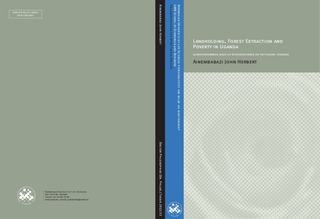| dc.contributor.advisor | Angelsen, Arild | |
| dc.contributor.advisor | Holden, Stein | |
| dc.contributor.author | Ainembabazi, John Herbert | |
| dc.coverage.spatial | Uganda | nb_NO |
| dc.date.accessioned | 2018-05-08T09:08:51Z | |
| dc.date.available | 2018-05-08T09:08:51Z | |
| dc.date.issued | 2012 | |
| dc.identifier.isbn | 978-82-575-1089-3 | |
| dc.identifier.issn | 1503-1667 | |
| dc.identifier.uri | http://hdl.handle.net/11250/2497503 | |
| dc.description.abstract | Motivated by a large body of literature that suggests land is a key determinant of livelihood strategies for farm households in developing countries, this thesis offers insights on how the mode of land acquisition at the time of household formation influences household decisions to invest in land, and then examines how landholding determines two other key household decisions: first, the decision to switch from subsistence production to a crop mix of food and cash crop production, following a policy reform of export-crop (coffee) market liberalization, and second, the decision to extract uncultivated products such as forest products.
The thesis uses a diversity of analytical approaches applied on a range of different datasets from Uganda to understand these household decisions. The findings indicate that although inheritance is the main form of land acquisition, inheritance discourages investment in land and encourages land disposal through both sales and bequests. The initially landless or nearlandless households accumulate landholding over time and catch up with the initially land rich households, and land markets serve to make the land distribution more equal.
The thesis further finds that households poor in productive assets like land and livestock extract charcoal from natural forests, and that this makes it possible to catch up with more asset-rich neighbors. The extraction continues until they accumulate necessary income to acquire productive assets after which exit is possible. Another paper focuses on extraction of forest products mainly for subsistence use, and the impacts of commercial forest plantations established to reduce the pressure on natural forests. While the thesis finds that this policy has had a modest conservation effect, it concludes that policy initiatives designed to conserve forests can be made more effective if they are introduced with complementary interventions that change characteristics that reduce forest use, including the asset holdings | nb_NO |
| dc.language.iso | eng | nb_NO |
| dc.publisher | Norwegian University of Life Sciences, Ås | nb_NO |
| dc.relation.ispartofseries | PhD Thesis;2012:53 | |
| dc.rights | Attribution-NonCommercial-NoDerivatives 4.0 Internasjonal | * |
| dc.rights.uri | http://creativecommons.org/licenses/by-nc-nd/4.0/deed.no | * |
| dc.title | Landholding, forest extraction and poverty in Uganda | nb_NO |
| dc.title.alternative | Landeiendommer, bruk av skogressurser og fattigdom i Uganda | nb_NO |
| dc.type | Doctoral thesis | nb_NO |
| dc.subject.nsi | VDP::Social science: 200::Economics: 210::Economics: 212 | nb_NO |
| dc.source.pagenumber | 158 | nb_NO |

